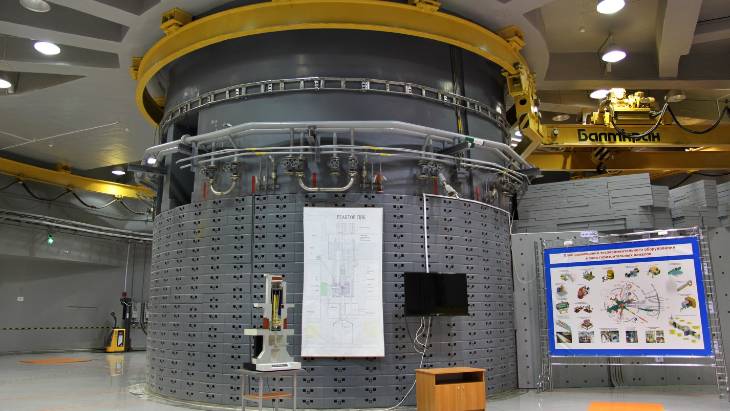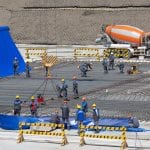Workers at the Research Institute of Atomic Reactors (RIAR) in Dimitrovgrad, Russia, have installed what they call the world’s largest multipurpose fast neutron research reactor, or MBIR, at the site.
The group on Jan. 18 said the installation of the MBIR, a milestone in the assembly of the reactor facility, was completed 16 months ahead of schedule. Workers will now proceed to installing the dome of the reactor building. The project is expected to enter operation in 2026 or 2027, ahead of a previous timeline that called for commissioning in 2028.
Officials in an email to POWER on Jan. 19 said the MBIR is a multipurpose fourth-generation fast neutron research reactor, being built as part of a Russian government program to develop nuclear science and technology. The Dimitrovgrad plant, in Russia’s Ulyanovsk region, after commissioning will be the most powerful operating research reactor in the world, according to Russia’s state-owned Rosatom nuclear power company. The 150-MW unit will replace a BOR-60 sodium-cooled fast reactor at the site that has operated since 1969.
Sodium-Cooled Fast Reactor
The MBIR is also a sodium-cooled fast reactor, and officials said it will have a design life of up to 50 years. The technology is a multi-loop research reactor capable of testing lead, lead-bismuth and gas coolants, and running on MOX (mixed uranium and plutonium oxide) fuel, according to Rosatom. The RIAR has said it intends to set up on-site closed fuel cycle facilities for the MBIR, using pyrochemical reprocessing it has developed at pilot scale.

Rosatom told POWER the new reactor will enable experiments and development of technology for the production of isotopes and “modified materials.”
“Installing the reactor vessel in its design position is a significant achievement of the work of a large team of like-minded scientists, engineers, designers, and builders,” said Yuri Olenin, deputy director general for Science and Strategy with Rosatom. Olenin told POWER, “This is an important milestone in the MBIR reactor construction project, bringing us closer to installing reactor equipment and reaching the end of construction, which is already ahead of schedule. This means that we will get an advanced research infrastructure in a shorter amount of time, which will advance the study of two-component nuclear power engineering technology and our efforts to close the fuel cycle; it will help accelerate and justify the creation of safe fourth-generation nuclear power plants, and foster breakthrough research over the next 50 years.”
Olenin added that “Rosatom’s MBIR research reactor and the Kurchatov Institute’s PIK reactor—Russia’s ‘megascience’ project—are complementary, providing for the entire possible range of neutron research, both in terms of neutron energy and in terms of possible objects of research.” The PIK research reactor complex is located in Gatchina, at the St. Petersburg Institute of Nuclear Physics. The PIK reactor, which entered service in February 2021 and is one of just four high-flux research reactors worldwide, is a “beam-type reactor research facility with a thermal power of 100 MW, which makes it possible to place up to 50 scientific stations on extracted neutron beams,” according to Rosatom.

Research Center Also Being Built
The MBIR reactor vessel is 12 meters long, with a 4-meter diameter. It weighs more than 83 metric tons. The vessel was delivered to the site in April of last year, after being transported from a Rosatom’s Atommash manufacturing facility in Volgodonsk in Russia’s Rostov region.
Rosatom officials said having the reactor at the RIAR site will make it “possible to both expand the scientific and production capabilities of Rosatom and the nuclear industry as a whole over the next 50 years, as well as make it possible to carry out socially significant projects in the city and the region, including the construction of a new low-rise residential building for highly qualified experts and scientists.”
Construction of the MBIR project is occurring at the same time that the IRC MBIR, an international research center, is being built in Dimitrovgrad. Officials describe the IRC MBIR as a “global center of expertise in fast reactors [that] will bring together representatives of leading international and Russian scientific institutions.”
Rosatom told POWER on Thursday that about 1,400 workers, including engineering and technical personnel, along with more than 80 pieces of construction machinery are currently at the site. The Research and Development Institute of Power Engineering, JSC, is the project’s chief design group. The scientific supervisor is IPPE JSC, part of Rosatom’s scientific division. The general designer is the State Specialized Design Institute.
Institute Orgenergostroy, JSC, a Moscow-based group, is the general construction contractor. Both the Russian and foreign specialists involved in the project are working under the management of the IRC MBIR.
—Darrell Proctor is a senior associate editor for POWER (@POWERmagazine).










